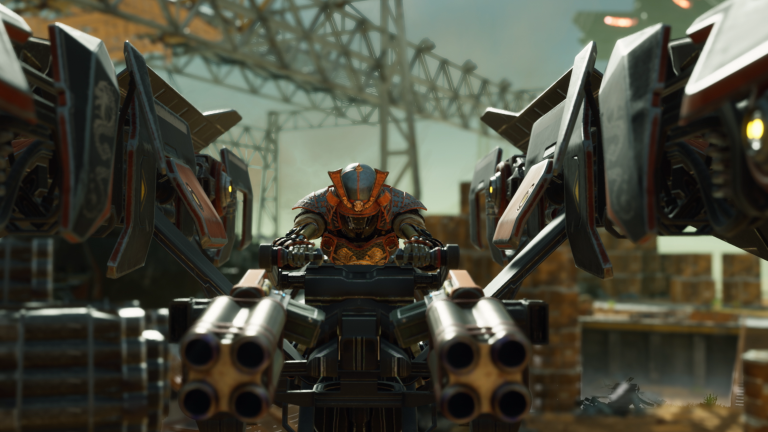Disintegration Review: Promising Halo-Inspired Multiplayer Action
Disintegration is a new game from a team led by a former Halo dev. As you'd expect, the game is more than a little inspired by Halo but also introduces new ideas to its action-packed multiplayer.

Pedigree is a funny thing in the video game industry. On the one hand, if you’re familiar with a developer and have enjoyed their previous work, odds are that you’ll like the next game they put out. But pedigree also means that a new IP can carry some heavy expectations that are very difficult, if not impossible, to meet.
As the inaugural title from V1 Interactive, a small studio founded by Halo co-creator Marcus Lehto and other former Bungie staffers, Disintegration is leaning hard on its pedigree to make a name for itself in the crowded first-person shooter genre. And while Disintegration may not live up to the legendary exploits of Master Chief, there are some unique ideas here, bolstered by a fantastic multiplayer mode, that make the game worth trying for yourself.
Disintegration takes place 150 years in the future on an Earth ravaged by climate change, disease, and economic collapse. To survive, humans have developed a process called “integration” that implants human brains into robotic bodies. But trouble arises when a militant group named Rayonne attempts to establish its rule over the last vestiges of humanity. You play as rebel leader Romer Shoal and a ragtag group of other integrated humans attempting to overthrow Rayonne.
Originally planned as a real-time strategy game, Disintegration is a squad-based first-person shooter where you direct 1-4 members of your squad through various missions. The big twist is that at all times, you’re in a “gravcycle,” which is exactly what it sounds like: a large, gravity-defying motorcycle that allows you to lead the aerial assault as well as your troops on the ground.
In single-player, the gravcycle is both a blessing and a curse. You don’t have a ton of health, so getting above the action to tell your squad where to go and who to attack is vital. But being stuck in such a clunky vehicle can also make it difficult to move around during a firefight. More than once, while trying to escape danger, I got caught on something in the environment, and the result was fiery death. And if you want to interact with anything in the world, like health crates, you can’t do that on your own, either. You have to direct your squad to do it for you.
V1 also somewhat bafflingly uses the gravcycle as an excuse to limit which weapons you can use on during missions. You really liked the dual machine guns you used in the last level and would like to make them your go-to loadout? Too bad, you’re getting cannons and rockets for this next level.
When everything is working correctly, going into combat with your squad will make you feel like you’re a part of an unstoppable walking and floating rebel force. One unit freezes enemies with a slowdown field, while the other launches missiles, and all the while I rain hellfire from above, taking out a half-dozen mechanical enemies in one fell swoop. But curious design choices continually hold back this power fantasy. For one thing, many squad powers have lengthy cooldowns. These can be decreased by purchasing upgrades with chips and salvage found in the world, but the problem never completely goes away.
Release Date: June 16, 2020
Platforms: PS4 (reviewed), XBO, PC
Developer: V1 Interactive
Publisher: Private Division
Genre: Shooter
While there is an emergency boost button to get out of bad situations, that too has a lengthy cooldown, which can pose some serious problems when your squad members go down in a firefight and you have only 30 seconds to get in and out of a hot zone to retrieve their remains or fail the mission. And if you go down, it’s back to the last checkpoint, which can mean losing several minutes of hard-fought progress.
Frustratingly, while missions (which can last nearly an hour) have regular checkpoints, if you quit to the main menu in the middle of a level, you don’t restart at the checkpoint the next time you load up the game. You have to begin the mission all over again. I can’t remember the last time I played a shooter like this that didn’t save progress mid-mission.
All members of the squad are directed simultaneously with the R1 button on the PS4. That often makes it difficult to get characters to go where you want them to or to target specific enemies who are just out of range. And every now and then, you’re dropped into a mission without any squad members at all, which makes for an experience that’s more frustrating than fun because so much of the game is built around your squad.
Whether you have to go it alone or are suddenly swarmed by a surge of powerful enemies, the occasional difficulty spike does the campaign no favors. While other squad-based shooters feel like a well-choreographed ballet, Disintegration often just feels chaotic.
Disintegration does have a strong art style, though. The interesting character designs are clearly influenced by Halo and Destiny. And more than once, while making my way through the game’s varied levels, I expected to look up and see the other side of Halo’s trademark ring.
There are also plenty of cutscenes in the 8-10 hour campaign, featuring some impressively strong voice acting. For all of its flaws, Disintegration’s voice acting is consistently great, which is good because your squad does like to talk a lot both on- and off-mission. Unfortunately, cutscenes also highlight some of Disintegration’s technical flaws. The frame rate often dropped below 30 fps during cutscenes and more frenetic firefights while playing on an original PS4.
I had to play through Disintegration’s single-player campaign on a base PS4 because the game repeatedly crashed on the first mission when I tried to play on a gaming laptop meeting the minimum system requirements. V1 has said that these issues should be fixed by launch, but even the PS4 version of the same mission crashed at one point during my playthrough. Here’s hoping the stability issues are ironed out soon.
Something strange happens when playing Disintegration‘s far better multiplayer mode. Many of the issues that hold back the single-player campaign actually work to the multiplayer’s advantage. Weapons are still locked to your gravcycle, but that just creates nine unique classes you have to learn to properly coordinate. Your squad can still go down easily, but now you have more of a motivation to collect their remains right away so they’ll respawn more quickly.
Multiplayer crews (the different types of squads you can command) include tank-like King’s Guard unit; the Sideshows, which prefer laying down traps and guerrilla tactics; the samurai-inspired offensive-minded unit known as the Lost Ronin; the Militia, which specialize in demolitions; and the more balanced Business unit. All of these squads offer a different flavor of gameplay and your mileage will vary with each, but you’ll definitely discover some favorites.
And that chaotic combat that often feels so frustrating while playing alone? It’s an absolute blast watching multiple squads simultaneously duke it out on the ground while gravcycles launch bullets and missiles above in 5v5 combat. I didn’t even run into any technical issues during my time with multiplayer on the PC, aside from some slowdown.
Disintegration is launching with six maps and three multiplayer modes: Zone Control, Collector, and Retrieval. Zone Control is a hectic race to capture territories that can come down to the wire, as you command your ground units around the map. Gravcycles can’t capture zones so keeping your squad alive and supporting them from the air is vital to success.
Collector is somewhat inspired by Halo‘s Headhunter match type where teams have to collect skulls from dead enemies to score points. Disintegration‘s twist on this is that you’re collecting “brain cans.” There’s a bit more strategy to this mode than simply running and gunning, though. Since downed enemy gravcycles are worth three brain cans and defeated units are only worth one brain can each, you constantly need to balance the risk and reward of going after other players or their ground units. You’ll have to adapt quite a bit.
Retrieval, Disintegration‘s play on a capture the flag match type or Halo‘s Assault bomb modes, is the best of the three modes. The format is simple: one team must try to steal “cores” from a defending team and deliver them back to their spawn point before a timer runs out. Retrieval is a constant back and forth that requires the most teamwork out of the three modes. Work together and you’ll have a good chance to outsmart the defending force, which will constantly try to destroy your units as they carry the core back to base.
It’s clear that V1 incorporated a lot of the lessons learned from Halo into these modes, and I’m hopeful the game’s multiplayer component can find an audience. It’s by far the standout of this release and a component I hope V1 will continue to build upon with new modes and maps.
Like any offspring, Disintegration has picked up quite a few things from of its predecessors — both good and bad. But it also surprises with a few new tricks of its own. While the single-player campaign often falters, the promising multiplayer mode echoes some of the better parts of Halo’s design. That’s a good start.

